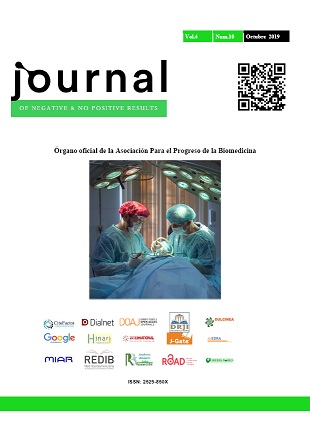Indicators of Depression in Adults Older than 60 to 75 years in Ixmiquilpan Hidalgo
DOI:
https://doi.org/10.19230/jonnpr.3056Keywords:
depression, geriatric, affective disorder, older adults, characteristic symptomsAbstract
Depression today represents a serious public health problem, is a very common affective disorder in people over 60 and female, sadness, crying, isolation, isolation, sleep disorders and suicidal ideation are the characteristic symptoms of this condition. Primary prevention is overwhelming to avoid major consequences, hence the importance of using geriatric instruments for the diagnosis of this condition that today seems to represent everyday life.
Objective. Identify Depression Indicators in Older Adults of Ixmiquipan Hidalgo.
Material and methods. A descriptive, cross-sectional observational study was carried out in 57 people; 43 of the female gender and 14 of the male gender between 60 and 75 years of age, through the application of the Geriatric Depression Scale GDS Yesavage instrument originating in Ixmiquilpan Hidalgo, Mexico.
Results. Of the 57 people surveyed, the highest participation with 75% corresponds to women and 25% to men, where the greatest impact in terms of indicators of depression with 35% corresponds to the female gender and 7% to the male gender.
Conclusion. Women present a higher percentage of depression indicators with respect to men, this makes it necessary to design strategies that predict better results and avoid non-positive results in older adults.
Downloads
References
Avila-Funes. Sintomas depresivos como fartor de riesgo en adultos mayores. (2007).
Robledo, L. G. Geriatría. México. El Manual Moderno. (2006)..
Fontecha, B. Valoración geriátrica: visión desde el hospital de día. Revista Multidisciplinar de Gerontología, (2005).15 (1), 23-25.
Meléndez Moral C, T. M. Análisis de las redes sociales en la vejez atravez de la entrevista. Pub México: Manheim. (2007)..
Díaz, M. D., Pascual, B. & Calvo, F. Trastornos afectivos en el anciano. Revista Multidisciplinar de Gerontología, (2002). 12, 19-25.
Thomas, C. M. & Morris, S.. Cost of depression among adults in England in 2000. British Journal of Psychiatry, (2003).183, 514-519.
Sánchez, R. & Echeverry, J. Validación de escalas de medición en salud. Revista de Salud Publica, (2004).6, 302- 318
Yesavage, J. & Brink, T. L. Development and validation of a Geriatric Depression Screening Scale: A preliminary report. Journal of Psychiatric Research, (1983).17, 37-49.
Arthur, A., Jagger, C., Lindesay, J., Gram, C. & Clarke, M. Using an annual over-75 health checks to screen for depression. Validation of the Short Geriatric Depression Scale (GDS-15) within general practice. International Journal of Geriatric Psychiatry, (1999).14, 431-439.
Yesavage, J. A., Brink, T.L., Rose, T.L., Lum, O., Huang V., Adey, M. & Leirer, V. O. Development and validation of a geriatric depression screening scale: a preliminary report. Journal of Psychiatric Research. EBSCO, (1982).37- 49
Sheikh, J., Yesavage, J., Brooks, J., Friedman, L., Gratzinger, P., Hill, R., & Crook, T. Proposed factor structure of the Geriatric Depression Scale. International Psychogeriatrics / IPA, (1991).3(1): 23-28. Extraido de EBSCOhost.
Published
Issue
Section
License
All accepted originals remain the property of JONNPR. In the event of publication, the authors exclusively transfer their rights of reproduction, distribution, translation and public communication (by any sound, audiovisual or electronic medium or format) of their work. To do so, the authors shall sign a letter transferring these rights when sending the paper via the online manuscript management system.
The articles published in the journal are freely used under the terms of the Creative Commons BY NC SA license, therefore.
You are free to:
Share — copy and redistribute the material in any medium or format
Adapt — remix, transform, and build upon the material
The licensor cannot revoke these freedoms as long as you follow the license terms.
Under the following terms:
Attribution — You must give appropriate credit, provide a link to the license, and indicate if changes were made. You may do so in any reasonable manner, but not in any way that suggests the licensor endorses you or your use.
NonCommercial — You may not use the material for commercial purposes.
ShareAlike — If you remix, transform, or build upon the material, you must distribute your contributions under the same license as the original.
No additional restrictions — You may not apply legal terms or technological measures that legally restrict others from doing anything the license permits.

This work is licensed under a Creative Commons Attribution-NonCommercial-ShareAlike 4.0 International License

























